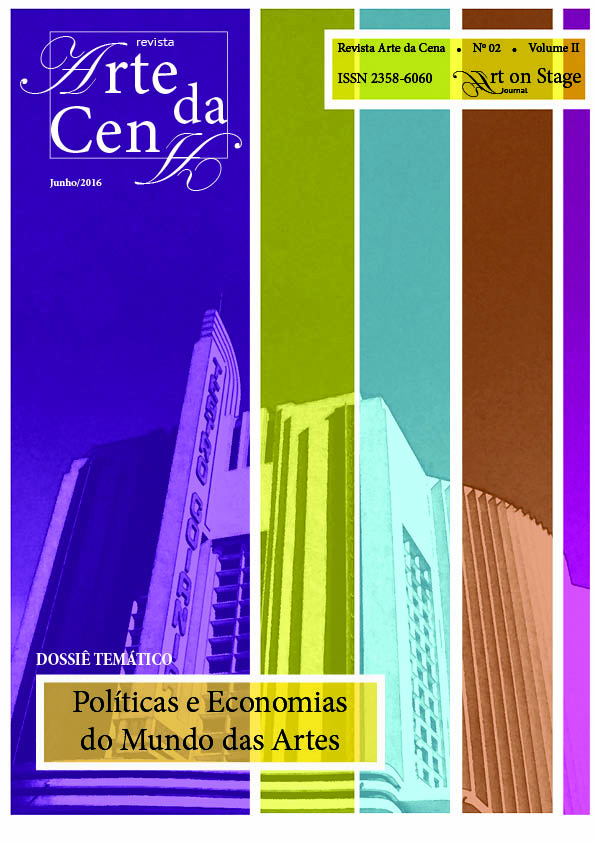THE DIONYSOS’ MYTHICAL DRAMA: BETWEEN THE INTOXICATING RAPTURE AND SACRED LYRICISM
DOI:
https://doi.org/10.5216/ac.v2i2.43680Keywords:
Dionysos, Myth, Dithyramb, Greek Theatre, Rituals, Sacred Dances.Abstract
This article outlines the trajectory of Dionysos’ myth, the deity of intoxicating ecstasy and the sacred lyricism, and investigates what distinguish as sacred Dionysian that goes beyond the limits authoritative by moderate Apollo, as well as the rudiments of ritualistic dances and the beginning of the Greek theater . For this, retraces the path of Dionysus in ancient times, exploring the imagery of creation and its various expressions ground of the mythology, the symbolism, rituals and art as conditions for its survival in Classical Greece. The main objective is to demonstrate the syncretic plot of the symbology of these elements in different cultural expressions which are rooted and originate decisions and actions that shape the boundaries between objectivity and subjectivity in the conception of artistic materiality, placing this in the transcendent area that is transfigured in real. In this discussion, it addresses the aspect of Dithyramb and agrarian rituals that revive symbolism, imagery and resignify archaic myths that reactualized and vivify prehistoric rituals in contemporary times.
Downloads
References
BOLEN, Jean Shinoda.Os Deuses e os Homens: uma nova psicologia da vida e dos amores masculinos. Tradução de Maria Sílvia Mourão Netto. 2. ed. São Paulo: Paulus, 2005.
BRANDÃO, Junito de Souza. Teatro Grego: tragédia e comédia. 9. ed. Petrópolis: Vozes, 2002.
ELIADE, Mircea. Mito e Realidade. Tradução de Póla Civelli. São Paulo: Perspectiva, 2007.
NEUMANN, Erich. A Grande Mãe: um estudo fenomenológico da constituição feminina do inconsciente. São Paulo: Cultrix, 1999.
SCHECHNER, Richard. Between Theather and Antropology. Philadelpia: The University of Pennsylvania Press, 1985.
SILVA, J. C. Avelino da. Teatro grego e realidade social. In: Caminhos. Revista do Mestrado em Ciências da Religião, UCG. Goiânia: Ed. da UCG, v.1, n.2, jul./dez. 2004. p. 185-207.
SILVA, J. C. Avelino da. Disciplina Mestrado -O conceito de alma em Platão, (Paper) PPGSCR-PUC-Goiás 2010.
TURNER, Victor. From Ritual to Theatre: the human seriousness of play. New York: PAJ Publications, 1982.
WOSIEN, Bernard. Dança: um caminho para a totalidade. São Paulo: Triom Editora, 2000.
WOSIEN, Maria-Gabriele. Danças Sagradas: o encontro com os Deuses. Madrid, Espanha:Edições Del Prado, 1997.
WOSIEN, Maria-Gabriele. O Anjo e a Serpente. Seminário. Tradução: Rassata. Brasília: Rodas da Lua. 2002.
WOSIEN, Maria-Gabriele. Dança: símbolos em movimento. Tradução de Bettina Aring Mauro. São Paulo: Anhembi Morumbi, 2004.
Downloads
Published
How to Cite
Issue
Section
License
The Art on Stage Journal uses the Creative Commons - Attribution-Non-Commercial 4.0 International license as a basis for transferring rights, for open access journals (Open Archives Initiative - OAI).
Authors who publish in this journal agree with the following terms:
1) Authors retain the copyright and grant the Art on Stage Journal the right to first publication, with the work simultaneously licensed under the Creative Commons Attribution Non Commercial License.
2) Authors are authorized to assume additional contracts separately, for non-exclusive distribution of the version of the work published in this Journal (eg, publishing in institutional repository or as a book chapter), with acknowledgment of authorship and initial publication in this journal.
3) Authors are allowed and encouraged to publish and distribute their work online (eg in institutional repositories or on their personal page) at any point before or during the editorial process, provided that the reference to the place of publication is cited, that is, the electronic address / reference of Art on Stage Journal.
4) The authors of the works published in the Art on Stage are expressly responsible for their content.
5) Authors will not be paid for publication of works in the Art on Stage Journal.



